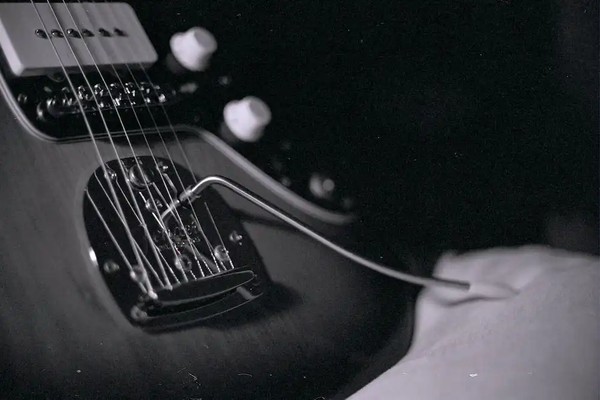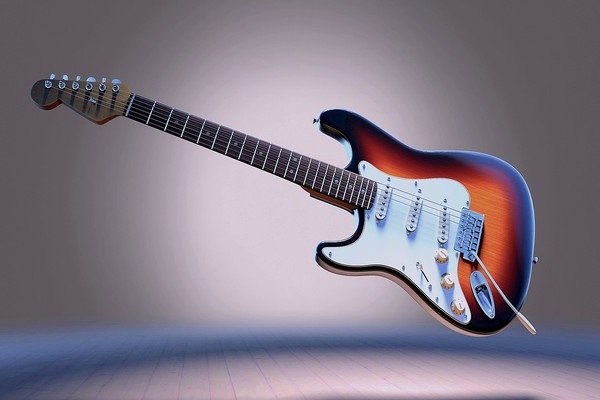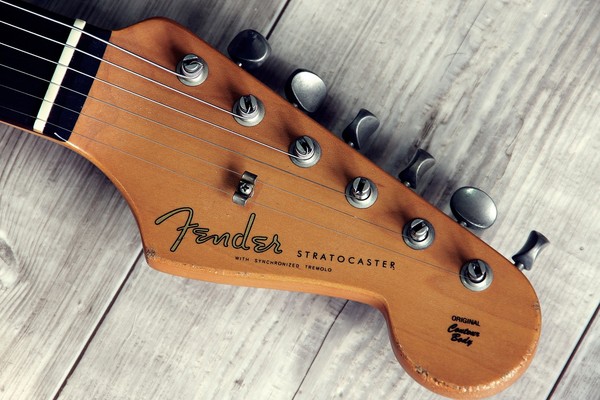
If you’re a guitarist, you’ve probably heard of a device called a whammy bar. This nifty device, also known as a tremolo arm, can add a whole new dimension to your playing. But have you ever wondered how does a whammy bar work? In this article, we’ll delve into the mechanism of the whammy bar, explore its different types, and discuss some tips and warnings for using it effectively. So, pick up your electric guitar, and let’s delve into the fascinating universe of whammy bars!
Table of Contents
What is the Mechanism of the Whammy Bar?
The tremolo bar is a device affixed to the bridge of your electric guitar. When you exert pressure by either pushing or pulling on the tremolo arm, it imparts tension to the strings, resulting in their bending and a subsequent change in the pitch of the notes you’re producing. This bend is responsible for the unique vibrato or tremolo sound. Essentially, the tremolo arm serves as a category of tremolo device attached to the bridge and tailpiece.

Image by Howcast from Google
Do You Pull or Push a Whammy Bar?
A common source of confusion among guitarists is whether to pull or push the whammy bar. The answer depends on the type of whammy bar you have. Some whammy bars are designed to be pulled towards you, while others are meant to be pushed away. It’s essential to know which type you have so you can use the whammy bar effectively. So, when using your electric guitar, experiment with pushing the whammy bar and pulling it to explore its full range and understand how to use whammy effectively.
If you don’t have a whammy bar, don’t fret! (pun intended) You can still create some fantastic sounds on your guitar. Techniques like bends and slides can mimic the effects of a whammy bar to some extent. However, having a whammy bar opens up a whole new world of possibilities and allows for more expressive playing.

Image by PIRO4D from Pixabay
Is a Whammy Bar Worth It?
The age-old question arises: is a whammy bar worth the investment? Well, that depends on your playing style and musical preferences. If you’re into genres like heavy metal or want to replicate the iconic sounds of guitar legends like Eddie Van Halen and Jimi Hendrix, then a whammy bar is definitely worth considering. It adds versatility and uniqueness to your playing. When considering the best whammy bar for your needs, explore different types of whammy bars, such as Floyd Rose, Bigsby, and Fender floating tremolo.
How Tight Should the Whammy Bar Be?
The tension of your whammy bar is crucial for achieving the desired effects. If the whammy bar is too loose, it might not return to its original position accurately. On the other hand, if it’s too tight, it can hinder your ability to use the whammy bar smoothly. Experiment with different tension levels until you find the sweet spot that works for you. When adjusting the tension, keep in mind the different types of whammy bars, such as locking tremolo, floating tremolo, Floyd Rose tremolo, and others.

Image by sweetwater from Google
What Can You Do Without a Whammy Bar?
Does a Whammy Bar Change Pitch?
Absolutely! That’s the primary purpose of a whammy bar – to change the pitch of the notes you play. By pushing or pulling the bar, you can either raise or lower the pitch, adding a dynamic and expressive element to your music. So, if you’re aiming for a dive bomb effect or subtle pitch shifts, the whammy bar is your go-to tool.
Tremolo Effect and Other Influences
The whammy bar introduces a unique tremolo effect, enhancing the expressiveness of your guitar playing. This effect has become one of the most famous and recognizable features in the world of guitarists. The arm that is attached to your guitar’s bridge plays a crucial role in producing the tremolo effect, influencing the pitch with tension on the strings. It is a part of the bridge, altering the pitch instead of manipulating the strings directly.
Influence from the Fender and Other Notes
The first whammy bar came from the Fender Stratocaster design, marking a pivotal moment in the evolution of this iconic guitar accessory. The pitch can be raised or lowered with tension on the strings, creating a distinctive vibrato bar effect. This design choice, influenced by Fender, has become a hallmark of the whammy bar. So, whether you’re playing a Fender Stratocaster or another type of electric guitar, the whammy bar’s design has roots in the Fender legacy.

Image by YS-Park from pixabay
Types of Whammy Bars and Installation
There are two main types of whammy bars – those you pull towards you and those you push away. The main types of whammy bars include Floyd Rose, Bigsby, and Kahler, each offering unique features and capabilities. Whammy bars come installed on various guitars, with popular models like the Les Paul Bigsby showcasing their versatility. When installing a whammy bar, ensure it’s done correctly to avoid issues with the nut, bridge, and overall tremolo system.
Playing Techniques and the Guitar Body
Playing guitar with a whammy bar involves various techniques. You can push the bar towards or pull it away to achieve different effects. Experiment with the vibrato system by playing a note and then pushing or pulling the whammy bar. Play a note, raise the pitch, or create tremolos by utilizing the whammy bar’s range of motion. The guitar body, including the nut and bridge, plays a crucial role in the performance of the whammy bar. The strings may go out of tune, but regular tuning adjustments can address this issue.
Wrap Around a Metal Bar: Utilize a Whammy Bar
One distinctive feature is that some whammy bars wrap around a metal bar. This design choice allows for unique playing techniques, such as wrapping the whammy bar around and pushing it towards the guitar body. This method contributes to the versatility and range of effects achievable with the whammy bar.

Image by Ichimi from pixabay
Installation and Key Players
Having a whammy bar installed on your guitar opens up a world of possibilities. Popular whammy bar models, including Floyd Rose and Kahler, offer everything you need for expressive playing. The bar returns to its original position after use, allowing for seamless integration into your playing style. Many people use synchronized tremolo systems, taking advantage of the whammy bar’s capabilities.
Additional Notes on Playing Techniques
In addition to pushing the bar towards or pulling it away, explore synchronized tremolo techniques. This involves manipulating the whammy bar to produce a tremolo effect that complements your playing style. Instead of the strings, focus on the note, and then push or pull the whammy bar to create dynamic pitch changes.
Does a Whammy Bar Untune a Guitar?
Ah, the eternal struggle of guitarists everywhere – keeping their guitars in tune. While it’s true that using a whammy bar can cause your strings to go out of tune, it’s not the end of the world. With proper setup and regular tuning adjustments, you can minimize this issue. Plus, there are locking tremolo systems available that provide better stability and tuning retention.
Tips:
· Take some time to get familiar with your whammy bar and its range of motion, especially if it’s your first locking tremolo or floating tremolo experience.
· Experiment with different whammy bar techniques like dive bombs and subtle pitch shifts to discover the full range of your electric guitar’s capabilities.
· If you’re installing a whammy bar for the first time, consider seeking professional help to ensure it’s done correctly. Proper installation is crucial, especially with tremolo bridge like the Floyd Rose.
· Remember to tune your guitar regularly, especially after using the whammy bar extensively. Keeping your guitar in tune is essential for optimal performance.
Warnings:
· Be cautious when using the whammy bar aggressively, as it can put additional strain on your guitar’s neck and bridge.
· Avoid excessive force or sudden movements to prevent damage to your guitar. Whether you have a Fender Stratocaster with a floating tremolo or another type of guitar, gentle handling is key.
· It’s worth noting that different types of whammy bars may require specific adjustments and maintenance.
Refer to the manufacturer’s instructions for guidance on maintaining your Floyd Rose, Bigsby, or other whammy bar systems.
Conclusion
We’ve covered a lot of ground here. We’ve explored the inner workings of a whammy bar, discussed its various uses and techniques, and even touched on the eternal tuning struggle. Remember, the whammy bar is a lever that enhances your playing, so use it wisely and have fun exploring its potential. Whether you’re influenced by the Fender Stratocaster, Eddie Van Halen’s whammy bar techniques, or the heavy metal scene with Floyd Rose bridges, the whammy bar is a versatile companion on your musical journey. Rock on!






